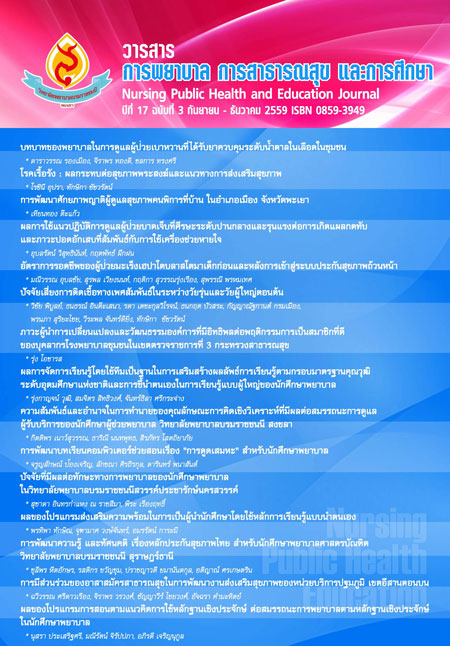โรคเรื้อรัง : ผลกระทบต่อสุขภาพพระสงฆ์ และแนวทางการส่งเสริมสุขภาพ
Keywords:
โรคไม่ติดต่อเรื้อรัง, โรคเรื้อรัง, การส่งเสริมสุขภาพ, พระสงฆ์, Non Communicable Disease, ChronicDisease, HealthPromotion, Thai MonkAbstract
ในปัจจุบันโรคไม่ติดต่อเรื้อรัง หรือ โรคเรื้อรัง ส่งผลกระทบรุนแรงทั้งด้านเศรษฐกิจ สังคม และการพัฒนาในประเทศต่างๆ ทั่วโลก ในประเทศไทย ข้อมูลจากองค์การอนามัยโลกในปี พ.ศ. 2553 พบว่า ประมาณร้อยละ 71 ของการเสียชีวิตทั้งหมดเกิดจากโรคไม่ติดต่อเรื้อรัง และประมาณ ร้อยละ 29 ของการเสียชีวิตจากโรคไม่ติดต่อเรื้อรังเกิดในผู้ป่วยอายุน้อยกว่า 60 ปี โดยสัดส่วนการเสียชีวิตจากโรคหลอดเลือดหัวใจ ร้อยละ 27 โรคมะเร็งร้อยละ 12 โรคระบบทางเดินหายใจ ร้อยละ 7 และโรคเบาหวาน ร้อยละ 6 ซึ่งจำนวนผู้เสียชีวิตจากโรคดังกล่าวมีแนวโน้มเพิ่มสูงขึ้น และส่งผลกระทบต่อภาระค่าใช้จ่ายในการดูแลรักษาทั้งในระดับบุคคล ครอบครัว และระดับประเทศ นอกจากประชาชนแล้วพระสงฆ์คือกลุ่มหนึ่งที่ควรได้รับการดูแลเนื่องจากพบว่าพระสงฆ์ที่อาพาธด้วยโรคไม่ติดต่อเรื้อรังมีแนวโน้มเพิ่มมากขึ้น ซึ่งภาวะดังกล่าวมีผลกระทบต่อคุณภาพชีวิตของพระสงฆ์สถิติความเจ็บป่วยของพระสงฆ์ไม่ได้แสดงถึงผลกระทบทางด้านการพัฒนาสุขภาวะคนไทยเท่านั้น แต่ยังส่งผลโดยรวมต่อเศรษฐกิจของประเทศ ดังนั้นรูปแบบที่เหมาะสมในการส่งเสริมสุขภาพแก่พระสงฆ์ จึงต้องการเกิดจากการมีส่วนร่วมของทุกฝ่าย และสอดคล้องกับ ศรัทธาความเชื่อและวิถีชีวิตของชุมชนนอกจากนี้รูปแบบการส่งเสริมสุขภาพแก่พระสงฆ์ที่เหมาะสมต้องสอดคล้องกับพระธรรมวินัย และเป็นที่ยอมรับขององค์กรสงฆ์เพื่อเอื้อให้พระสงฆ์เกิดพฤติกรรมสุขภาพที่เหมาะสมและมีสุขภาพดีได้ในที่สุด
Chronic Disease: Impact on Thai Monk Health and Health Promotion
To date Noncommunicable Diseases (NCD) have high impact in economy social as well as country development worldwide. In Thailandas reported by the World Health Organization in 2010, found that dead in Thailand approximately 70% were related with NCD while 29% of dead reported occurred in the people under 60 years old. The main cause of dead were due to Cerebrovascular Disease 27% Cancer 12% Respiratory System Disease 7% and Diabetes Mellitus 6%. The percentage of people die due to NCD trends to rise and has high impact on expenditure in treatment individually family and country. Beside the population of the country, Thai monk are the other group that should be taken care of as it was found that numbers of Thai monk suffering from NCD are rising and this is related to the Thai Monk quality of life. The statistic which show the Thai monk suffering with NCD does not only show impact on health promoting among Thai population only but it also effected the country economy. Hence it is important that providing Health promoting in Thai Monk should be provided by all the sectors. In Addition, it is important that the health promotion pattern provided to the Thai Monk should meet the Buddhist Vinaya and accepted by the Thai Monk organization, so that it could enhanced the Thai Monk health behavior and finally have good health.


